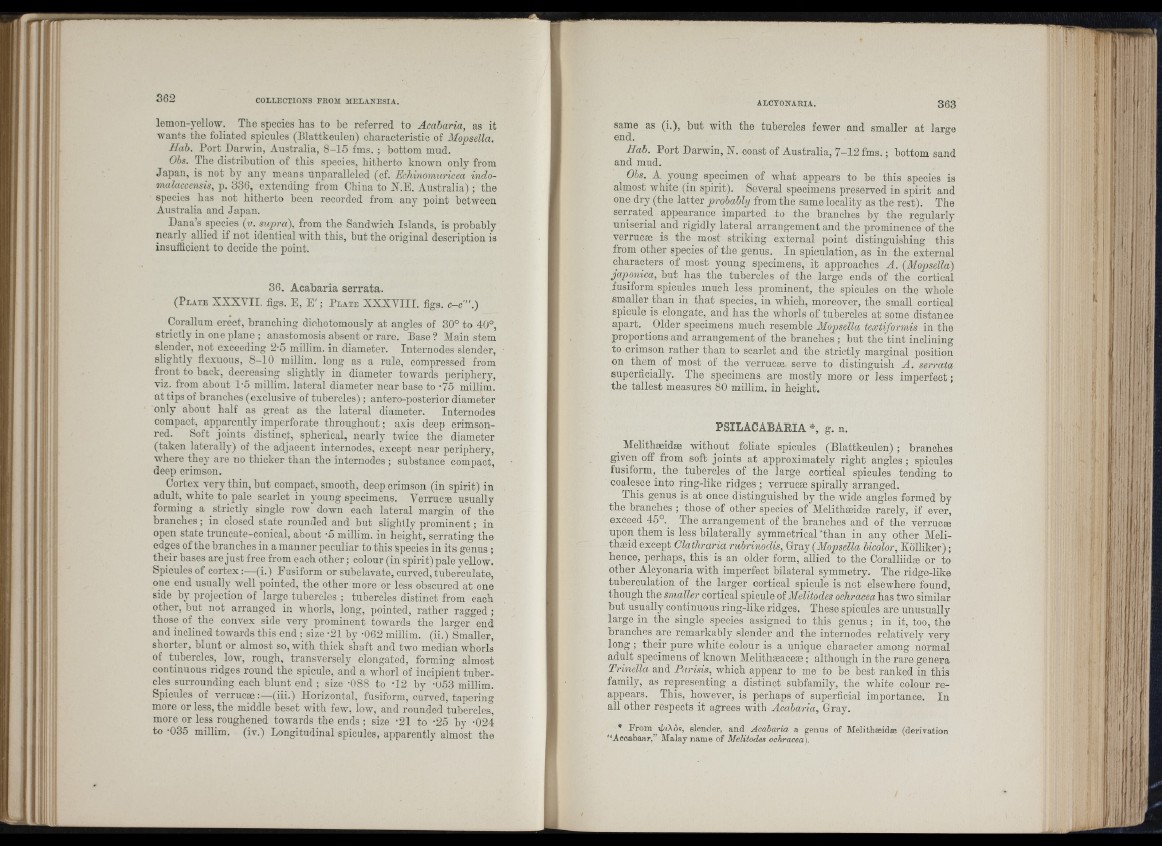
J -
lemon-yellow. The species has to be referred to Acaharia, as it
wants the foliated spicules (Blattkeulen) characteristic of Alopsella.
Hab. Port Darwin, Australia, 8-15 fms. ; bottom mud.
Ohs. The distribution of this species, hitherto known only from
Japan, is not by any means unparalleled (cf. Echinomuricea indo-
malaccensis, p. 33G, extending from China to X.E. Au stralia); the
species has not hitherto been recorded from any point between
Australia and Japan.
Dana’s species {v. supra), from the Sandwich Islands, is probably
nearly allied if not identical with this, hut the original description is
insufficient to decide the point.
36. Acaharia serrata.
( P l a t e XXXVII. figs. E, E' ; P l a t e X X X V III. figs. c-c"'.)
Corallum erect, branching dichotomously at angles of 30° to 40°,
strictly in one plane ; anastomosis absent or rare. Base ? Alain stem
slender, not exceeding 2-5 millim. in diameter. Internodes slender,
slightly flexuons, 8-10 millim. long as a rule, compressed from
front to hack, decreasing slightly in diameter towards periphery,
viz. from about 1-5 millim. lateral diameter near base to -75 millim.
at tips of branches (exclusive of tubercles) ; antero-posterior diameter
only about half as great as the lateral diameter. Internodes
compact, apparently imperforate throughout ; axis deep crimson-
red. Soft joints distinct, spherical, nearly twice the diameter
(taken laterally) of the adjacent internodes, except near periphery,
where they are no thicker than the internodes ; substance compact,
deep crimson.
Cortex very thin, hut compact, smooth, deep crimson (in spirit) in
adult, white to pale scarlet in young specimens. Verrucæ usually
forming a strictly single row down each lateral margin of the
branches ; in closed slate rounded and but slightly prominent ; in
open state truncate-conical, about -5 millim. in height, serrating the
edges of the branches in a manner peculiar to this species in its genus ;
their bases are ju st free from each other ; colour (in spirit) pale yeUow!
Spicules of cortex:—(i.) Eusiform or subclavate, curved] tuberculate,
one end usually wæll pointed, the other more or less obscured at one
side by projection of large tubercles ; tubercles distinct from each
other, bnt not arranged iji whorls, long, pointed, rather ragged ;
those of the convex side very prominent towards the larger end
and inclined towards this end ; size -21 by -062 millim. (ii.) Smaller,
shorter, blunt or almost so, with thick shaft and two median whorls
of tubercles, low, rough, transversely elongated, forming almost
continuous ridges round the spicule, and a whorl of incipient tubercles
surrounding each blunt end ; size '088 to -12 by -U53 millim.
Spicules of verrucæ (iii.) Horizontal, fusiform, curved, tapering
more or less, the middle beset with few, low, and rounded tubercles,
more or less roughened towards the ends ; size -21 to -25 by -024
to -035 millim. (iv.) Longitudinal spicules, apparently almost the
same as (i.), but with the tubercles fewer and smaller at large
end.
Hab. Port Darwin, X. coast of Australia, 7-12 fms. ; bottom sand
aud mud.
Ohs. A young specimen of what appears to be this species is
almost white (in spirit). Several specimens preserved in spirit and
one dry (the latter probably from the same locahty as the rest). The
serrated appearance imparted to the branches by the regularly
uniserial and rigidly lateral arrangement and the prominence” of the
verrucæ is the^ most striking external point distinguishing this
from other species of the genus. In spiculation, as in the external
characters of most young specimens, it approaches A. (Aloqosella)
japonica, but has the tubercles of the large ends of the cortical
fusiform spicules much less prominent, the spicules on tho whole
snialler than in th at species, in which, moreover, the small cortical
spicule is elongate, and has the whorls of tubercles at some distance
apart. Older specimens much resemble Aloptsella textiformis in the
proportions and arrangement of the branches : but the tin t inclining
to crimson rather than to scarlet and tho strictly marginal position
on them of most of the verrucæ serve to distinguish A . serrata
superficially. The specimens are mostly more or less imperfect ;
the tallest measures 80 millim. in height.
PSILACABARIA *, g. n.
_ Alelithæidæ without foliate spicules (Blattkeulen) ; branches
given off from soft joints at approximately right angles ; spicules
fusiform,^ the tubercles of the large cortical spicules tending to
coalesce into ring-like ridges ; verrucæ spirally arranged.
This genus is a t once distinguished by the wide angles formed by
the branches ; those of other species of Alelithæidæ rarely, if ever,
exceed 45°. The arrangement of the branches and of the verrucæ
upon them is less bilaterally symmetrical‘than in any other Aleli-
thæid except Clathraria ruhrinodis, Gray {Alopsella hicolor, Kolliker) ;
hence, perhaps, this is an older form, allied to the Coralliidæ or to
other Alcyonaria with imperfect bilateral symmetry. The ridge-like
tuberculation of the larger cortical spicule is not elsewhere found,
though the smaller cortical spicule oi Alelitodes ocJiracea has tivo similar
but usually continuous ring-like ridges. These spicules are unusually
large iu the single species assigned to this in it, too, the
branches are remarkably slender and the internodes relatively very
lo n g ; their pure white colour is a unique character among normal
adult specimens of known Alelithaeacese ; although in the rare genera
Trinella and Parisis, which appear to me to be best ranked in this
family, as representing a distinct snbfamiljq the white colour reappears.
This, however, is perhaps of superficial importance. In
all other respects it agrees with Acaharia, Gray.
* slender, and Acaharia a genus of Alelithaeidae (derivation
“Accabasr,” Malay name of Melitodes ochracea).
f i